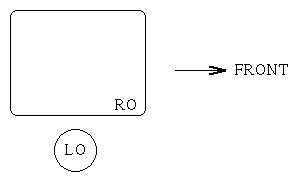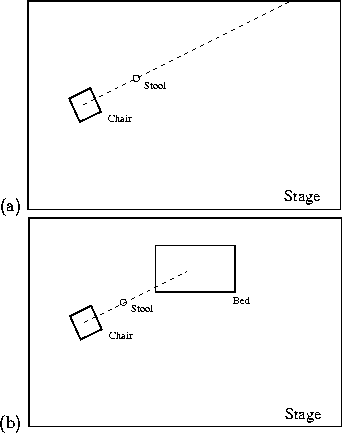
LITERATURE REVIEW
Much interest has been evinced in recent years in the field of understanding and modelling spatial relations. Proper understanding of how the human mind classifies such relations between objects can have tremendous applications in the field of Cognitive science and Computer Science in general and Artificial Intelligence in particular.

Fig 1 : LO to-the-right-of RO. A spatial preposition describes
a relationship
(in-front-of) between LO and one or more ROs.
A spatial preposition is one which describes the relationship in space between a located object (LO) and one or more reference objects (ROs). A lot of work has been done in trying to develop computational models for representing spatial expressions.

Fig 2: a) a discretised approach b) a continuum field approach c) the potential plot for in-front-of, showing the sweet spot.
Many formalisms focused on discretised models of space for computing spatial relations. These models divided the space into discrete regions based on alignment or tangency. However, there is no evidence to suggest that the human mind functions in this manner. Further, the discretised models are not adequately able to handle distance and proximity constraints within a particular discretised space and hence prepositions like "near", "far" and "between" etc.
( Socher, G. et-al 1997 ) have proposed a model which seeks to do away with some of the problem by using a discretised model of space in which each region has a certain predefined acceptance for a particular spatial preposition. This is then used to compute a degree of acceptability of a given spatial relation between objects.
( Mukerjee, A. 1997 , Gapp, K-P. 1994 ) An intuitively better approach appears to be the one using the continuum model. Here, the spatial relation is viewed as a fuzzy class over the quantitative space based on a measure such as membership function on a continuum set. A number of models use potential fields to model spatial prepositions. In this approach, a potential field is defined through a set of parameters such as size and shape of LO and ROs, distance from ROs, enclosure etc. This potential field quantifies applicability of the spatial relation it models - the lower the potential the higher the applicability. Thus, in-front-of potential can be visualised as a field with minima at a point in front of RO called the sweet point and with low values for points near the sweet spot and high values for points far from the sweet spot. The RO itself represents a very high value.
An open question for such an approach, however, is the determination of nature of potential field function. ( Mukerjee, A. 1998 ) describes various potential fields that can be used. Multiple constraints can be handled by simply addition of different field components in a continuum and normalisation if needed.
(Gapp, K-P. 1997) conducted psychometric tests to validate his computational model, in which subjects were asked to judge the applicability of spatial prepositions used to describe spatial relations between objects on a screen. The main intention here was to classify the dependencies between angle, distance and shape when establishing spatial relationships.
Also, the question of how the enclosure affects the implication of spatial relations needs to be looked at.

Fig 3: The problem of enclosure-- in (a), the available space in front of the chair is restricted by the boundary of the stage, while in (b) the available space is bound by the chair and the bed.
OUR WORK IN PERSPECTIVE
Through our experiment, we have tried to study how the various factors mentioned above -- including the size of the enclosure, the size and shape of the RO and the LO, the spatial preposition being considered-- affect the position of the sweet spot, the most likely location of the center of the LO. Our method, thus, is intrinsically linked to the potential field approach of Mukerjee and Gapp.
There has been a lack of uniform opinion about the nature of the potential field function. We have chosen to implement an elliptical potential field function which is both sufficiently constraining and easy to compute. However, this choice of field function is more a result of intuition than any empirical evidence in its favour. We hope to be able to empirically validate our choice sometime in the future.
In our survey of the connected literature, we have observed that researchers have focused on testing the validity of their intuitive assumptions ( e.g. Gapp, 1997 ). In our experiment, however, we have taken the converse approach. Rather than using human subjects as mere oracles to test the fitness of routines designed by us, we use the data provided by our subjects to tune our program and to make it more representative of the way in which humans reason psycholinguistically.